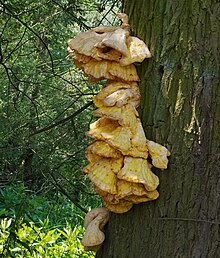Common brimstone
| Common brimstone | ||||||||||||
|---|---|---|---|---|---|---|---|---|---|---|---|---|

Common brimstone ( Laetiporus sulphureus ) |
||||||||||||
| Systematics | ||||||||||||
|
||||||||||||
| Scientific name | ||||||||||||
| Laetiporus sulphureus | ||||||||||||
| ( Bull .: Fr. ) Murrill |
The common Sulfur Porling ( Laetiporus sulphureus ) is a type of mushroom from the family of the Stielporlingsver related . The species was formerly part of the family of the sulfur porling relatives (Laetiporaceae). Young, juicy specimens are edible and have a chicken flavor when cooked. This gave the mushroom the name "Chicken of the Woods" in the English-speaking world.
features
The many-hatched, often very large and conspicuous consoles have bright sulfur-yellow to orange colors and often grow at great heights on tree trunks. The hats are flat and usually spread out like a fan. The surface is velvety hairy, the edge is bent down and often zoned. The vividly sulfur-yellow colored underside is porous and wavy, the pores are irregularly round or somewhat elongated, there are 3–5 pores per millimeter. Guttation drops are often formed on the underside of the fruiting body . The tubes are about 5 mm long, the tube layer cannot be peeled off. Fresh specimens are juicy and soft, while older ones become brittle and chalky or cheese-like.
ecology
The common sulfur porling is a parasite whose mycelium occurs preferentially in deciduous trees , less often in conifers . It produces a noticeable brown rot in the wood . He prefers hardwoods with a colored core as a substrate . It can attack oak , locust , prunus species, poplar and willow ; in Central Europe , conifers ( larch ) are less common and more likely to be settled in higher elevations . In Central Asia, according to Dörfelt, this fungus parasitizes mainly in larch species; conifers are also attacked in North America. The Sulfur Porling can also colonize other deciduous trees. The infected trees often have entry gates for the spores in the form of larger injuries to the protective bark.
Because the fungus penetrates the tree through wounds. In the trunk it initially feeds on the breakdown of the heartwood. In the further course the sapwood is also attacked, which leads to increased susceptibility of the host trees to wind breakage. Thick whitish mycelium lobes are formed in the shrinkage cracks : "mycelium leather". After the host dies, it can continue to live as a saprobiont for a short time until the moistened part of the substrate is completely consumed.
Naturally, the sulfur porling occurs in alluvial forests and in more humid mixed oak forests. It is also found in other forest types, orchards, parks and on street trees.
distribution
The sulfur porling has been detected on all continents, in the Holarctic it is mainly found in warmer and temperate areas. According to Krieglsteiner, the European distribution area corresponds to that of the oak. It is relatively dense in Germany.
meaning
The sulfur pore is a parasite that causes intense brown rot and can lead to the death of the infected trees. The stability and breaking strength of infested trees is greatly reduced. With locust trees, the damage is often limited to the trunk.
Food value
When cooked, the mushroom is edible when cooked. Only the 4 cm of the outer hem should be used; because it quickly becomes tough and unpalatable. The sulfur porling is considered poisonous when raw. If the fungus grows on a poisonous tree, dangerous toxins can be transferred into the fungus. There have been observations that sulfur pores, e.g. B. grown on yews or locust trees can cause vomiting and diarrhea in sensitive people.
Remarks
- ↑ German J. Krieglsteiner considers the epithet “ sulphureus ” to be wrong and gives “ sulfureus ” as the correct spelling , but does not give any further reasons.
swell
literature
- Peter Schütt, Hans J. Schuck, Bernd Stimm: Lexicon of tree and shrub species . The standard work of forest botany. Morphology, pathology, ecology and systematics of important tree and shrub species. Nikol, Hamburg 2002, ISBN 978-3-933203-53-3 .
- German Josef Krieglsteiner (Ed.): The large mushrooms of Baden-Württemberg . Volume 1: General Part. Stand mushrooms: jelly, bark, prick and pore mushrooms. Ulmer, Stuttgart 2000, ISBN 3-8001-3528-0 , pp. 541-542.
- Francis WMR Schwarze, Julia Engels, Claus Mattheck: Wood-decomposing fungi in trees. 1st edition. Rombach Verlag, Freiburg im Breisgau 1999, ISBN 3-7930-9194-5 , pp. 102-109
- Heinrich Dörfelt , Gottfried Jetschke (Ed.): Dictionary of mycology. 2nd Edition. Spectrum Academic Publishing House, Heidelberg / Berlin 2001, ISBN 3-8274-0920-9 .
- Josef Breitenbach, Fred Kränzlin (Ed.): Mushrooms of Switzerland. Contribution to knowledge of the fungal flora in Switzerland. Volume 2: Heterobasidiomycetes (gelatinous mushrooms), Aphyllophorales (non-leaf mushrooms), Gastromycetes (belly mushrooms). Mykologia, Luzern 1986, ISBN 3-85604-020-X .
Individual evidence
- ^ British Mycological Society: English Names for fungi 2012. Retrieved July 21, 2012 .
- ↑ The host trees can also affect the taste. Sulfur porlings that grow on oaks can sometimes taste “a bit tart” due to their tannic acid. Franz Engel: mushroom hikes. A mushroom guide for everyone . Ed .: Paula Engel. Franckh'sche Verlagshandlung, Stuttgart 1966, DNB 456539700 , p. 11 .
- ↑ Bruno Hennig, Hans Kreisel, Edmund Michael: The most important and most common mushrooms with special consideration of the toadstool . In: Handbook for mushroom lovers . 5th edition. tape 1 . VEB Gustav Fischer, Jena 1983.



